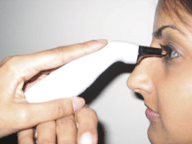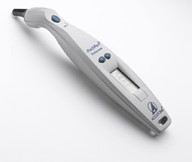Tina Romanay trials a new handheld pachymeter and argues that pachymetry should be a regular technique for optometrists in future.
 Pachymetry is the name given to the technique which involves measuring the thickness of the central part of the cornea. The cornea is approximately 540 to 550 microns thick in the centre, and 1,000 microns thick in the periphery. The most common technique for obtaining corneal measurement is ultrasound due to its availability, accuracy and cost effectiveness. Pachymetry can also be measured by optical low coherence reflectometry.
Pachymetry is the name given to the technique which involves measuring the thickness of the central part of the cornea. The cornea is approximately 540 to 550 microns thick in the centre, and 1,000 microns thick in the periphery. The most common technique for obtaining corneal measurement is ultrasound due to its availability, accuracy and cost effectiveness. Pachymetry can also be measured by optical low coherence reflectometry.
It is becoming an integral part of clinical practice, used for studying the corneal function in a number of medical disease conditions, for example glaucoma, and with various types of refractive surgery.
The Goldmann tonometer (considered to be the gold standard for measuring intraocular pressure) was designed with the assumption that most eyes had a standard corneal thickness of around 520 microns, with little variability occurring in the absence of corneal pathology.
However, in the 1970s, Niels Ehlers MD demonstrated that there was significant variability in corneal thickness and, as a result, corresponding variability of Goldmann tonometry readings.
Results of the Ocular Hypertension Treatment Study (OHTS) in 2002 showed that central corneal thickness (CCT) was an important predictor for those patients with ocular hypertension progressing to glaucoma, with the thinnest corneas conveying the highest risk. The OHTS also indicated that corneal thickness is even more variable than had been previously suspected. Among the 1,636 patients enrolled in the study, most had corneal thickness above normal and over 25 per cent had corneal thickness above 600 microns.
An ultrasound pachymeter uses the principles of A-scan ultrasonography. It provides a convenient means of measuring corneal thickness. To measure corneal thickness, the ultrasonic beam is aligned perpendicular to the central corneal surface. Ultrasonic echoes are obtained from the anterior and posterior surfaces of the cornea. The time interval between the echoes can be used to determine the corneal thickness if the ultrasonic speed of propagation in the cornea is known. 
DESIGN OF THE PACHPEN
The new Accutome Pachpen is designed to be a light portable hand-held pachymeter. It uses state-of-the-art high resolution, real-time waveform analysis to measure the central corneal thickness. The adjustable speed of sound allows for precise readings to be taken. The soft probe tip, which is 2.5mm in diameter and slightly concave in shape, ensures patient comfort when applanation takes place and is said to minimise epithelial damage. An LCD screen displays the measured corneal thickness, the entered IOP, corrected IOP and average for all measurements taken. Control buttons allow you to scroll between all readings taken. The Pachpen has been designed ergonomically to fit into the hand for fast and accurate measurements.
ITS USE
As applanation of the cornea is required, the non-detachable probe needs to be sterilised before use on each patient. Isopropyl alcohol wipes are supplied with the instrument; alternatively sodium hypochlorite can also be used for disinfection (see College of Optometrists guidelines regarding recommendations for disinfection of probes). The probe can also be inspected under a slit-lamp bio-microscope for any surface defects, and it is here that concave shape of the probe can also be seen. Instillation of benoxinate is also required to anaesthetise the patient's cornea before using the Pachpen.
The Pachpen is designed in the shape of a pen, with an angled front head which allows the probe to be placed perpendicularly on the cornea.
Once the lithium battery has been installed, the instrument is always powered; left unused it switches into standby mode. Any of the three control buttons can be pressed briefly to restore the unit to full power. It takes seconds for the instrument to carry out a calibration check after which the measure screen is displayed.
The instrument is ready to be used if the display reads zero, if this is not the case, the up/down buttons can be held down for a few seconds simultaneously and the instrument will re-set itself to zero. The speed of sound can be altered, but I left it at the factory default setting.
To take a reading of the corneal thickness, once anaesthetic had been instilled, the action control button located near the tip of the pen was pressed; two beeps and a rotating line on the LCD display informed me that the instrument was ready to be used. The probe was then applied to the central part of the cornea and the instrument proceeded to take nine readings beeping each time a reading had been successfully taken. Once all nine readings had been taken, the instrument sounded three further beeps to tell me that the test was complete. Now the up/down buttons could be pressed to view the individual nine readings taken, with the average of the readings being displayed constantly at the bottom of the screen. Of the nine measurements taken, the one with an asterisk next to it informed me that this was the furthest from the average and could be deleted in order to recalculate the average and therefore give a more accurate reading. In order to calculate the true IOP value, the action control button was held down for a few seconds so that the measured IOP (MIOP) screen was displayed. Here the up/down control buttons could be used to enter the measured IOP (M), which in turn gave the true IOP (T). To reset the instrument the up/down control buttons were pressed simultaneously for a few seconds, a single beep and the screen measurements displaying zero again indicated that the instrument was ready to be reused.
MANIPULATION OF DATA AND STORAGE
Weighing in at only 3oz, the Pachpen was certainly light and comfortable to hold. The pen fitted comfortably in my hand and I found the easiest way to hold it was indeed like a pen between my thumb and first finger with the LCD screen visible upright. In this position the action control button located near the tip could be easily pressed with my first finger and the probe could be placed immediately on to the cornea for a reading to be taken. I found holding the Pachpen upside down with the LCD screen and control button not visible to be cumbersome, the patient was more aware of the instrument and the screen could not be seen to view the rotating line that confirmed when the instrument was ready to take a reading. The appearance of the rotating line was particularly useful if like me while chatting to the patient you forgot that the instrument had beeped to tell you that it was ready to be used.
It was very useful to have a beeping signal while readings were being taken and this helped ensure that the probe was in fact in contact with the cornea.
On my first attempt I asked the patient to look directly ahead. However, I found that this disconcerted them as they saw the probe coming directly towards them. On my second attempt, I found it easier to ask the patient to rest their head back against the chair headrest and look up slightly toward the ceiling. This meant that the patient could not immediately see the probe or my hand coming towards them and I could place the probe more accurately on the central cornea to obtain a reading.
Like the Perkins handheld tonometer, I initially found stabilising the probe on the central cornea a bit tricky. However, I found that using my left hand and the patient's shoulder as a rest improved stability. Although the speed of sound setting could be altered, I chose to leave it at the factory default setting. The flexibility to adjust this setting would be useful if the user wanted to vary the propagation of the speed of sound and assess its effect on corneal thickness. If the speed of sound has been altered and the Pachpen switches to standby mode, the speed of sound returns to the factory default setting when powered up.
Once all nine readings were taken, the mean corneal thickness measured in microns was clearly displayed on the LCD screen. The up/down buttons could then be used to scroll through the nine readings and any anomalous readings could easily be removed from the results to give a new and more accurate reading. Pressing the action control button for a few seconds then changed the display screen so that the measured IOP reading could be entered. This along with the on-board algorithm (after Doughty and Zamen) was used to determine true IOP. All the readings taken would have to be recorded on the patient's record card as there was no facility to store the data long term.
CONCLUSION
As a first-time user I found the Pachpen very easy to use. Initial nerves and stabilisation issues meant that some variability in corneal measurements occurred. However with user training and improved patient instruction results were repeatable and accurate. The beeping sounded aided me in ensuring that the probe was perpendicular to the cornea and therefore a reading was being taken. Patients reported no discomfort in the procedure, and slit-lamp examination of the cornea following measurement revealed no epithelial damage.
The Pachpen is designed to take nine readings to obtain an average. However, there is no explanation in the literature as to why exactly nine readings are taken, which I felt would be useful to know.
Furthermore, although the instrument allows you to remove the reading furthest from the mean to give a more accurate value, deletion of one reading only highlights the next anomalous reading with an asterisk, which in theory means eight readings could be deleted in this manner leaving only one measurement. The manufacturer should offer advice as to what reading is considered to be erroneous and therefore erasable; otherwise all nine readings should be kept to allow a greater mean reading to be achieved.
It would be prudent to remind all users to take IOP measurements before using the Pachpen, so that the results of the measured IOP can then be entered in order to determine the true IOP value.
Pachymetry is becoming more routine in US optometric practice. The OHTS makes it clear that central corneal thickness is an important part of assessing patients with ocular hypertension, there is also some value to knowing the corneal thickness of eyes with established glaucoma.
A common approach to glaucoma management is to set a target IOP, but the inability to accurately measure an individual's IOP makes the process of establishing and achieving the target IOP difficult. Therefore, if the corneal thickness is not known, the target pressure could be too low or too high.
With this in mind, I feel that pachymetry should become more routinely utilised in UK optometric practice, as this might facilitate more shared-care opportunities between eye care professionals.
Priced at £1,995, the Accutome Pachpen will to appeal to current users of pachymeters looking for a lightweight and portable alternative. It will also appeal to optometrists who are interested in shared-care opportunities and wish to increase the scope of their clinical practice.
Thanks to Keeler for use of the instrument. (For details, please contact: 01753 857177)
Tina Romanay is director of the Fight for Sight Optometry Clinic, City University
